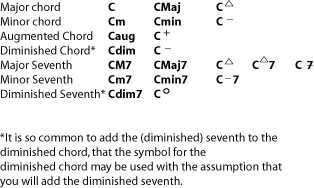| << Chapter < Page | Chapter >> Page > |
There is widespread agreement on how to name chords, but there are several different systems for writing chord symbols. Unfortunately, this can be a little confusing, particularly when different systems use the same symbol to refer to different chords. If you're not certain what chord is wanted, you can get useful clues both from the notes in the music and from the other chord symbols used. (For example, if the "minus" chord symbol is used, check to see if you can spot any chords that are clearly labelled as either minor or diminished.)

If you take a basic triad and add a note that is a seventh above the root , you have a seventh chord . There are several different types of seventh chords, distinguished by both the type of triad and the type of seventh used. Here are the most common.

Listen to the differences between the C seventh , C major seventh , C minor seventh , C diminished seventh , and C half-diminished seventh .
Write the following seventh chords. If you need staff paper, you can print this PDF file

Write a Ddim7, Fdim7, G#dim7, and Bdim7. Look closely at the chords you have written and see if you can notice something surprising about them. (Hint: try rewriting the chords enharmonically so that all the notes are either natural or (single) flat.

The seventh is not the only note you can add to a basic triad to get a new chord. You can continue to extend the chord by adding to the stack of thirds , or you can add any note you want. The most common additions and extensions add notes that are in the scale named by the chord.

The first, third, and fifth (1, 3, and 5) notes of the scale are part of the basic triad. So are any other notes in other octaves that have the same name as 1, 3, or 5. In a C major chord, for example, that would be any C naturals, E naturals, and G naturals. If you want to add a note with a different name, just list its number (its scale degree ) after the name of the chord.

Notification Switch
Would you like to follow the 'Introduction to music theory' conversation and receive update notifications?